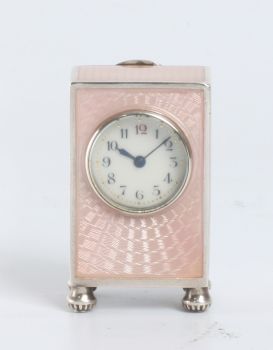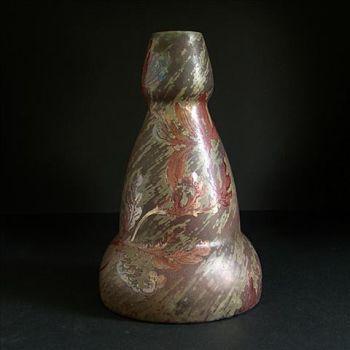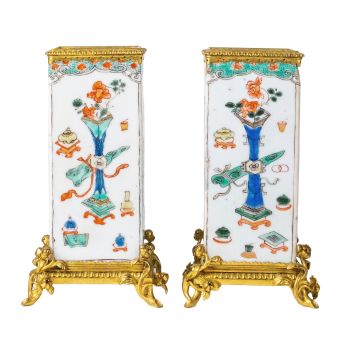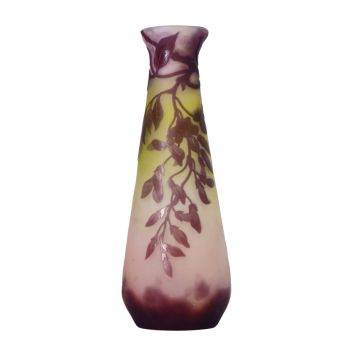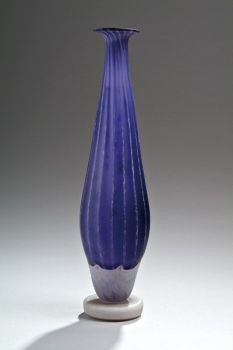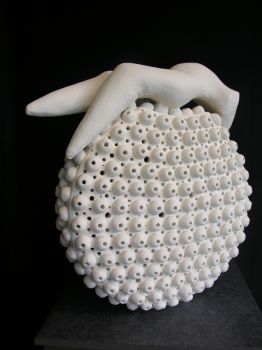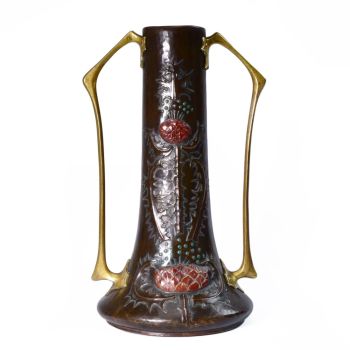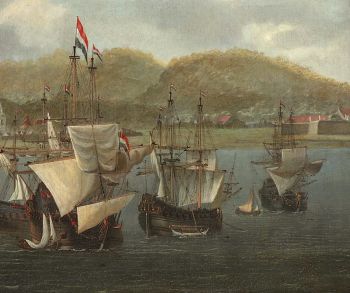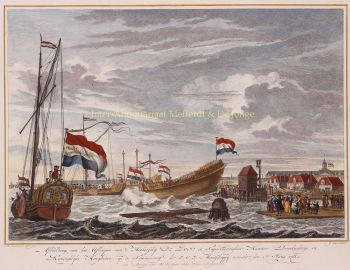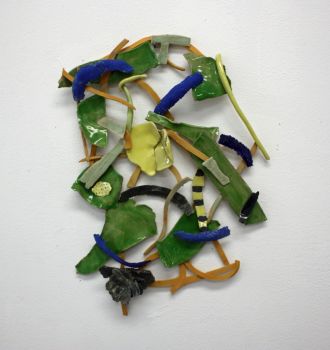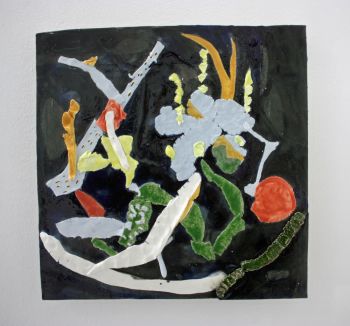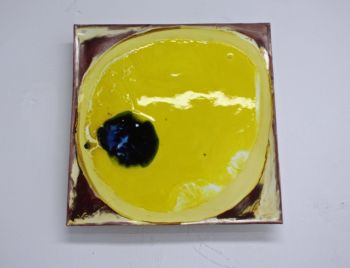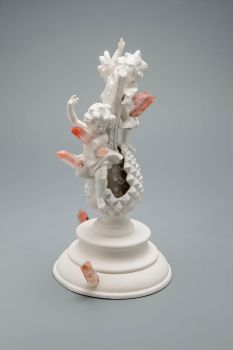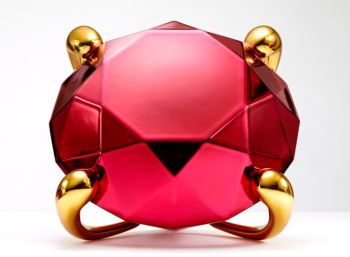UNA GRAN EXPORTACIÓN ARMORIAL CHINA PORCELANA AZUL Y BLANCA 'VAN DER DOES - STEIN VAN GOLLENESSE' CH 1755
Artista Desconocido
PorcelanaPorcelana china
ø 38 cm
Precio a consultar
Zebregs & Röell - Fine Art - Antiques
- Sobre la obra de arteQianlong period, circa 1755
Blue and white porcelain painted with a double coat of arms beneath a crown to the centre, the rim with three peony sprays between bands of diaper pattern, in the centre, two coats-of-arms.
Diam. 38.4 cm
Note:
On the left are those of Van der Does. They had been born this way by ennobled by King William I since the beginning of the 16th century. The arms on the right are those of the (van) Stein van Gollenesse family. Julius (van) Stein van Gollenesse (1691-1755) was the first to bear these arms in Colombo in 1748. His daughter, Anthonia Dorothea, who married Gerard van der Does, bore these arms on a seal of 1766.
This armorial service was made for Gerard van der Does (Gouda 1732 - Batavia 1758) and Anthonia Dorothea (van) Stein van Gollenesse (Batavia 1740 - Zwolle 1774) on the occasion of their marriage in Batavia on 25 July 1755.
Gerard van der Does belongs to an ancient and prominent family, originally from Croisilles (France) but settled in Holland since about 1320. The family owned the manor house Ter Does near Leiderdorp. In the 15th and 16th centuries, members of the Van der Does family belonged to the patriciate of Delft and Leiden. Later branches with several family members occupied prominent positions in Gouda, Dordrecht, Amsterdam, Gorinchem and ‘s Hertogenbosch. In 1815 this branch was ennobled in the Netherlands. Gerard's father, Adriaan (1686-1749), councillor and alderman in Gouda, and his wife Catharina de Grande (1688-1774) married in 1712 and belonged to the wealthiest inhabitants of Gouda. They had ten children of which Gerard was the youngest. Gerard joined the VOC before 1754 as a junior merchant, then became “Tweede in de Groote Winkel” (second shop keeper), merchant and “Eerste Suppoost van het Comptoir-Generaal”. In 1755 he was appointed alderman of Batavia, but his career was a short one, he died three years later. - Sobre el artista
Puede suceder que un artista o creador sea desconocido.
Algunas obras no deben determinarse por quién está hecho o por (un grupo de) artesanos. Algunos ejemplos son estatuas de la Antigüedad, muebles, espejos o firmas que no son claras o legibles, pero también algunas obras no están firmadas en absoluto.
También puedes encontrar la siguiente descripción:
•"Atribuido a …." En su opinión, probablemente una obra del artista, al menos en parte.
•“Estudio de….” o “Taller de” En su opinión, una obra ejecutada en el estudio o taller del artista, posiblemente bajo su supervisión
•“Círculo de…” En su opinión, una obra del período del artista que muestra su influencia, estrechamente asociado con el artista pero no necesariamente su alumno.
•"Estilo de …." o “Seguidor de…”. En su opinión, una obra ejecutada al estilo del artista pero no necesariamente por un alumno; puede ser contemporáneo o casi contemporáneo
•"Manera de …." En su opinión una obra al estilo del artista pero de fecha posterior
•"Después …." En su opinión, una copia (de cualquier fecha) de una obra del artista
•“Firmado…”, “Fechado…” o “Inscrito” En su opinión, la obra ha sido firmada/fechada/inscrita por el artista. La adición de un signo de interrogación indica un elemento de duda.
•“Con firma…”, “Con fecha…”, “Con inscripción…” o “Lleva firma/fecha/inscripción” en su opinión la firma/fecha/inscripción ha sido añadida por alguien que no es el artista
¿Está interesado en comprar esta obra de arte?
Artwork details
Related artworks
Artista Desconocido
Cáliz veneciano alado1650 - 1700
Precio a consultarPeter Korf de Gidts - Antiquairs
1 - 4 / 12- 1 - 4 / 12
- 1 - 4 / 24
Artista Desconocido
A large Japanese Imari porcelain 'VOC Groningen' dish1800 - 1925
Precio a consultarZebregs & Röell - Fine Art - Antiques
Artista Desconocido
UN MODELO JAPONÉS DE UN NORIMONO, UN PALANQUÍN1650 - 1700
Precio a consultarZebregs & Röell - Fine Art - Antiques
Artista Desconocido
Dos retratos de estudio de Mas Marco Kartodikromo1900 - 1950
Precio a consultarZebregs & Röell - Fine Art - Antiques
1 - 4 / 24Artista Desconocido
Series of 6 Chinese cups and saucers (Yongzheng period)1722 - 1735
Precio a consultarKuipers Kunst & Antiek
1 - 4 / 24Artista Desconocido
UN NETSUKE MARINE MARFIL DE UN HOLANDÉS CON UN VENTILADOR CHINO18th century
Precio a consultarZebregs & Röell - Fine Art - Antiques
Artista Desconocido
UN RARO TELESCOPIO DE CUERO LACADO JAPONÉS GRANDE1750 - 1800
Precio a consultarZebregs & Röell - Fine Art - Antiques
Artista Desconocido
IMPORTANTE Y RARO PINTURA INDIA DE ESTILO DE COMPAÑÍA EN MARFIL QUE REPRESENTA UN DESFILE1850 - 1900
Precio a consultarZebregs & Röell - Fine Art - Antiques
 curada por
curada porDanny Bree
Dutch School
Llegada de un holandés de las Indias Orientales a Table Bay18th century
Precio a consultarZebregs & Röell - Fine Art - Antiques
Artista Desconocido
An Indian part-gilt silver-clad ceremonial sceptre or mace with a tiger’s head1850 - 1900
Precio a consultarZebregs & Röell - Fine Art - Antiques
 curada por
curada porDanny Bree
1 - 4 / 12








